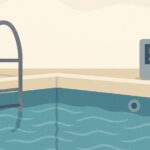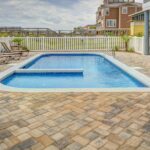Your salt system was working perfectly last week, and now you’re getting error codes, low chlorine production, or mysterious warning lights. Don’t panic – most salt system problems are fixable if you understand what’s actually happening and approach troubleshooting systematically. After years of diagnosing salt system failures throughout Tennessee, I’ve learned that most problems fall into predictable patterns with logical solutions.
This comprehensive troubleshooting guide will help you identify what’s wrong with your salt system, understand why it happened, and fix it correctly the first time. More importantly, you’ll learn how to prevent most problems from occurring in the first place.
⚡ Salt System Truth: “Your salt generator is a sophisticated piece of equipment that requires proper water chemistry and regular maintenance – it’s not a ‘set it and forget it’ solution.”
How Salt Water Chlorination Actually Works

The Electrolysis Process Explained
Before troubleshooting problems, you need to understand how your salt system creates chlorine:
Step 1: Salt Dissolution
- Salt (sodium chloride – NaCl) dissolves in pool water
- Creates sodium (Na+) and chloride (Cl-) ions in solution
- Optimal concentration: 2,700-3,400 ppm for most systems
Step 2: Electrolytic Cell Operation
- Water flows through the electrolytic cell containing metal plates
- Electrical current passes between positive and negative plates
- Current splits salt molecules through electrolysis
Step 3: Chlorine Generation
- Chloride ions combine with water to form hypochlorous acid (HOCl)
- Hypochlorous acid is the same sanitizing agent as traditional chlorine
- Sodium ions combine with hydroxide to form sodium hydroxide (raises pH)
Step 4: Chlorine Distribution
- Generated chlorine flows back into pool through return lines
- Chlorine sanitizes water exactly like traditional chlorination
- Process repeats continuously during system operation
Why Understanding This Matters
Common misconceptions that cause problems:
- “Salt systems don’t need chemicals” – Wrong, they still need balanced water
- “The system knows when to make chlorine” – Wrong, it runs on timers and settings
- “Salt level readings are always accurate” – Wrong, various factors affect readings
- “Any replacement parts will work” – Wrong, specifications matter critically
🔬 Chemistry Reality: “Salt systems are chlorine generators, not magic boxes. They require proper water chemistry and maintenance like any pool equipment.”
Proper Salt Levels and System Requirements
Optimal Salt Concentration Ranges
Most common systems:
- Hayward AquaRite: 2,700-3,400 ppm
- Pentair IntelliChlor: 2,700-3,400 ppm
- Generic systems: Check manufacturer specifications
Why salt level matters:
- Too low (under 2,500 ppm): Insufficient chlorine production, system alarms
- Optimal range: Maximum efficiency and equipment life
- Too high (over 4,000 ppm): Accelerated equipment corrosion, potential damage
The Importance of Quality Equipment
Reputable manufacturers (Hayward, Pentair) provide:
- Comprehensive warranties covering parts and labor
- Local dealer networks for service and support
- Consistent parts availability for years after purchase
- Technical support when problems arise
- Proven reliability in Tennessee’s challenging climate
Why quality matters in Tennessee:
- High heat stresses electrical components
- Extended season means more total operating hours
- Local dealer support crucial for timely repairs
- Warranty coverage protects significant investment
Avoid cheap imports and generic systems:
- Limited or no warranty coverage
- Parts availability disappears when manufacturers fail
- Poor quality control leads to premature failure
- No local technical support when problems arise
Understanding System Indicators and Warning Lights

Common Display Messages and Meanings
“Inspect Cell” or “Check Cell” Light
What it means:
- System detects reduced chlorine production efficiency
- Cell plates may have scale buildup or damage
- Water chemistry may be preventing proper operation
When this appears:
- Typically every 500-1000 operating hours (varies by manufacturer)
- Can appear early if water chemistry is poor
- May indicate actual cell problems or just routine maintenance need
Initial response:
- Check water chemistry first – pH, alkalinity, calcium hardness
- Inspect cell visually for obvious scale or damage
- Clean cell according to manufacturer instructions
- Reset indicator after cleaning (if problem was just maintenance)
“Low Salt” or “Add Salt” Warning
Critical mistake to avoid: Don’t automatically add salt when this appears!
Possible causes:
- Actually low salt levels (test independently)
- Dirty cell plates preventing accurate readings
- Poor water circulation through cell
- Control board calibration problems
- Cell damage affecting conductivity readings
Proper response:
- Test salt level independently with test strips or professional testing
- Clean cell if dirty – scale affects conductivity readings
- Check water flow through cell during operation
- Verify system calibration if salt level tests normal
“High Salt” Warning
What it indicates:
- Salt concentration above safe operating limits
- Risk of accelerated equipment corrosion
- Potential for scale formation throughout system
How this happens:
- Overaddition from following system readings instead of independent testing
- Evaporation concentrating existing salt (especially in Tennessee heat)
- System calibration problems giving false readings
Solutions:
- Confirm with independent testing before taking action
- Partial water replacement if truly high
- Never add salt-neutralizing chemicals – they don’t work reliably
“Flow” or “No Flow” Errors
What triggers this:
- Insufficient water flow through electrolytic cell
- Flow switch malfunction or debris blockage
- Pump problems affecting circulation
Tennessee-specific causes:
- Heavy debris loads from storms
- Clogged baskets from high pollen
- Equipment overwork from extended season
Troubleshooting steps:
- Check pump operation – Is water circulating normally?
- Clean skimmer and pump baskets – Remove all debris
- Inspect filter condition – Clean or backwash if dirty
- Verify valve positions – All suction valves open
- Check flow switch – May need cleaning or replacement
Systematic Salt System Troubleshooting

Problem: No Chlorine Production Despite Normal Operation
Diagnostic Steps
Step 1: Verify Actual Chlorine Levels
- Test free chlorine with reliable test kit
- Compare to system’s chlorine production setting
- Check if chlorine is being consumed faster than produced
Step 2: Confirm Salt Level Independently
- Use salt test strips or professional testing
- Don’t rely solely on system readings
- Ideal range: 2,700-3,400 ppm for most systems
Step 3: Inspect Cell Condition
- Remove cell and examine plates visually
- Look for scale buildup, corrosion, or damage
- Check for proper plate spacing and alignment
Step 4: Test Water Chemistry
- pH should be 7.2-7.6 for optimal chlorine production
- High pH reduces chlorine effectiveness
- Poor water balance affects cell operation
Common Causes and Solutions
Cause: Scale Buildup on Cell Plates
- Symptoms: White, chalky deposits on metal plates
- Why it happens: High pH, high calcium hardness, poor water balance
- Solution: Clean cell with muriatic acid solution, balance water chemistry
Cause: High Stabilizer Levels (Over 80 ppm)
- Symptoms: High chlorine readings but algae growth
- Why it happens: Stabilizer accumulates over time, locks up chlorine
- Solution: Partial water replacement to reduce stabilizer levels
Cause: Cell Plates Worn or Damaged
- Symptoms: Visual damage, holes, or severe corrosion on plates
- Why it happens: Age, poor water chemistry, electrical problems
- Solution: Cell replacement with genuine manufacturer part
Problem: System Shows “Low Salt” But Salt Level is Adequate
Why This Happens
Dirty cell affecting conductivity:
- Scale buildup interferes with electrical conductivity
- System can’t accurately read salt concentration
- Cleaning restores proper readings
Poor water circulation:
- Inadequate flow through cell reduces reading accuracy
- Clogged filters or baskets restrict flow
- Flow switch problems affect operation
Control board calibration issues:
- Electronic drift over time affects accuracy
- Temperature changes affect readings
- May require professional recalibration
Solution Process
- Clean cell thoroughly using manufacturer’s procedure
- Ensure adequate water flow through system
- Test salt level independently to verify actual concentration
- Reset system after cleaning and flow verification
- Professional calibration if problems persist
Problem: Excessive Salt Level Accumulation
How This Develops
The dangerous cycle:
- System shows “Low Salt” (due to dirty cell or calibration)
- Owner adds salt based on system reading
- Actual salt level rises above optimal range
- System still shows “Low Salt” (problem not fixed)
- More salt added, creating dangerously high levels
Tennessee amplification factors:
- High evaporation concentrates salt naturally
- Extended season means more opportunities for overaddition
- Heat affects system calibration accuracy
Prevention and Solution
Prevention:
- Always test salt independently before adding salt
- Clean cell regularly to maintain accurate readings
- Track salt additions to avoid overaddition
- Professional testing monthly during peak season
Solution for high salt:
- Confirm high salt with independent testing
- Partial water replacement – only effective solution
- Calculate replacement amount needed to reach target range
- Rebalance all chemistry after water replacement
Control Board vs Cell Failure Diagnosis
Identifying Cell Problems
Visual indicators of cell failure:
- Physical damage: Cracks, holes, or severe corrosion on plates
- Scale buildup: Heavy white deposits that won’t clean off
- Electrical damage: Burned or blackened areas on plates
- Structural damage: Bent or broken plates, housing cracks
Performance indicators:
- Gradual chlorine reduction over weeks or months
- Unable to maintain chlorine despite proper chemistry
- Cell cleaning doesn’t restore performance
- Visual damage during inspection
Testing cell function:
- Amperage draw test: Should meet manufacturer specifications
- Voltage test: Proper electrical input to cell
- Production test: Chlorine output measurement
- Professional diagnosis: Complex electrical testing
Identifying Control Board Problems
Electronic failure symptoms:
- Sudden complete failure – System won’t turn on
- Erratic operation – Random on/off cycling
- Display problems – Garbled or missing information
- Setting loss – System forgets programmed settings
Electrical indicators:
- Power supply problems – No voltage to system
- Circuit board damage – Visible burn marks or component failure
- Sensor communication problems – Flow or temperature sensor errors
- Programming corruption – System operates incorrectly
Testing control board:
- Power input verification – Proper voltage supply
- Output testing – Correct signals to cell
- Sensor input testing – Proper communication with sensors
- Professional diagnosis – Complex electronic troubleshooting
Age-Related Failure Patterns
Cell replacement timeline:
- 3-5 years: Normal replacement cycle with proper maintenance
- 1-3 years: Premature failure from poor water chemistry
- 5-7 years: Extended life with excellent maintenance
- Tennessee factors: Subtract 1-2 years due to extended season
Control board longevity:
- 5-10 years: Typical electronic component life
- Environmental factors: Heat, humidity, electrical surges affect life
- Quality differences: Name-brand boards last longer than generics
The Critical Importance of Genuine Replacement Parts
Why Genuine Parts Matter
Manufacturer specifications:
- Exact electrical requirements – Voltage, amperage, resistance
- Precise physical dimensions – Proper fit and seal integrity
- Quality materials – Corrosion resistance and longevity
- Performance testing – Verified chlorine production rates
Warranty and support benefits:
- Full manufacturer warranty on genuine parts
- Technical support when problems arise
- Guaranteed compatibility with existing equipment
- Professional installation support available
The Amazon Aftermarket Trap
Problems with generic/aftermarket parts:
- No warranty coverage – You’re on your own when they fail
- Unknown quality control – Inconsistent manufacturing standards
- Compatibility issues – May not fit or perform properly
- Short lifespan – Often fail within months instead of years
- No technical support – No one to call when problems arise
Tennessee-specific risks:
- No local dealer support for aftermarket parts
- Extended season exposes quality problems faster
- Hot climate accelerates failure of poor-quality components
- Service calls cost more than savings from cheap parts
Real cost analysis:
- Genuine cell: Higher upfront cost, 3-5 year life, full warranty
- Generic cell: Lower upfront cost, 6-18 month life, no warranty
- True cost per year: Genuine parts often cost less annually
Where to Buy Genuine Parts
Local pool dealers (recommended):
- Immediate availability for common parts
- Professional installation services available
- Warranty support and service relationships
- Technical expertise for proper diagnosis
Authorized online dealers:
- Genuine parts guarantee from authorized sources
- Manufacturer warranty honored
- Technical support available
- Proper part identification assistance
What to avoid:
- Unknown online sellers with generic parts
- “Compatible” or “replacement” parts without manufacturer approval
- Significantly below-market pricing – usually indicates generic parts
- No warranty information or support contact
Advanced Troubleshooting Techniques
Testing Water Chemistry for Salt System Optimization
Critical parameters for salt systems:
- pH: 7.2-7.6 – Affects chlorine production efficiency
- Total Alkalinity: 80-120 ppm – Stabilizes pH for consistent operation
- Calcium Hardness: 200-400 ppm – Prevents scale and corrosion
- Stabilizer: 30-50 ppm – Protects generated chlorine from UV
Tennessee testing considerations:
- Test more frequently during heat waves and storms
- Professional analysis monthly for accurate salt and stabilizer readings
- Temperature affects readings – Test when water is at normal temperature
Electrical System Diagnosis
Basic electrical checks:
- GFCI breaker status – Reset if tripped
- Voltage at control board – Should match specifications
- Control board to cell wiring – Check for loose or corroded connections
- Ground wire integrity – Critical for safety and operation
When to call professionals:
- Any electrical modifications or repairs
- Complex electronic diagnosis beyond basic checks
- Safety concerns with electrical components
- Warranty work requiring authorized service
Seasonal Maintenance Scheduling
Monthly during operating season:
- Visual cell inspection and cleaning if needed
- Independent water testing for all parameters
- System performance verification – chlorine production check
- Control board function test – All indicators and settings
Quarterly maintenance:
- Deep cell cleaning with acid solution
- Complete electrical inspection by qualified technician
- Control board calibration check if available
- Water chemistry professional analysis
Annual service:
- Complete system inspection by authorized dealer
- Preventive part replacement (gaskets, sensors)
- Electrical connection service – cleaning and tightening
- System performance optimization and calibration
Common Mistakes That Cause Expensive Problems
Adding Salt Without Independent Testing
The expensive cycle:
- System shows “Low Salt” due to dirty cell
- Owner adds salt without testing actual levels
- Salt level rises above optimal range
- System still shows “Low Salt” (cell still dirty)
- More salt added, requiring expensive water replacement
Prevention:
- Test salt independently before any additions
- Clean cell first when “Low Salt” appears
- Track all salt additions in maintenance log
- Professional testing when in doubt
Ignoring Water Balance for Salt Systems
Why water balance matters more:
- High pH reduces chlorine effectiveness and causes scale
- Low pH corrodes expensive cell plates rapidly
- Poor alkalinity causes pH swings that damage equipment
- High calcium creates scale that ruins cells
Tennessee water balance challenges:
- Heat accelerates all chemical reactions
- Evaporation concentrates all chemicals unpredictably
- Rain dilutes chemistry rapidly
Using Generic or Aftermarket Parts
Short-term vs long-term costs:
- Generic cell: Fails in 6-18 months, no warranty, no support
- Genuine cell: Lasts 3-5 years, full warranty, technical support
- Total cost: Genuine parts cost less per year of operation
Delaying Professional Service
When DIY troubleshooting reaches limits:
- Electrical problems beyond basic checks
- Repeated failures of same components
- Complex diagnostic equipment needed
- Warranty work requiring authorized service
Cost of delays:
- Secondary damage from continued operation with problems
- Water quality issues affecting swimmer safety
- Equipment damage from poor water chemistry
- Emergency service costs higher than preventive maintenance
Preventive Maintenance Schedule
Weekly Tasks (During Operating Season)
Visual inspections:
- Check system display for error codes or warnings
- Verify normal operation lights and indicators
- Listen for unusual sounds from equipment
- Observe water quality and chlorine levels
Basic testing:
- Test free chlorine levels independently
- Check pH levels and adjust if needed
- Visual inspection of cell through housing (if visible)
- Verify proper water flow through system
Monthly Tasks
Chemical analysis:
- Complete water testing including salt level
- Professional testing for accuracy verification
- Adjust water balance as needed
- Record all readings and adjustments
System maintenance:
- Remove and inspect cell condition
- Clean cell if scale buildup present
- Check all electrical connections
- Verify system programming and settings
Seasonal Tasks
Spring startup:
- Professional system inspection and service
- Cell cleaning and condition assessment
- Control board calibration verification
- Complete water chemistry balancing
Fall shutdown preparation:
- Final cell cleaning before reduced operation
- System performance evaluation
- Equipment protection for winter operation
- Maintenance schedule planning for next season
When to Replace vs Repair

Cell Replacement Indicators
Replace cell when:
- Visible damage to plates or housing
- Cleaning doesn’t restore chlorine production
- Age exceeds 3-5 years with declining performance
- Scale damage that can’t be removed
Repair cell when:
- Scale buildup responds to cleaning
- Performance restored after maintenance
- Recent installation with minor issues
- Warranty coverage available for repairs
Control Board Replacement Decisions
Replace control board when:
- Complete electronic failure – no display or operation
- Repeated component failures indicate board problems
- Age exceeds 7-10 years with reliability issues
- Repair costs approach replacement costs
Repair control board when:
- Single component failure with available parts
- Software/programming issues can be resolved
- Recent installation with warranty coverage
- Professional diagnosis confirms repairable problem
Conclusion
Salt system troubleshooting requires understanding both the chemistry and electronics involved in chlorine generation. Most problems result from poor water chemistry, inadequate maintenance, or using inferior replacement parts rather than actual equipment failure.
The key to salt system success in Tennessee’s challenging climate is consistent maintenance, proper water balance, and immediate attention to warning signs. Don’t ignore system indicators, but don’t blindly follow them either – independent testing and systematic diagnosis prevent expensive mistakes.
When replacement parts are needed, invest in genuine manufacturer components with full warranty support. The short-term savings from generic parts will cost you more in the long run through premature failures and lack of support.
Remember that salt systems are sophisticated equipment requiring proper care, not maintenance-free solutions. With proper understanding and maintenance, quality salt systems provide years of reliable chlorine generation and comfortable swimming.
⚡ Salt System Success: “Independent testing + systematic diagnosis + genuine parts + professional support = reliable salt system operation for years.”
Most salt system problems are preventable through proper maintenance and water chemistry management. When problems do arise, systematic troubleshooting and quality replacement parts will restore reliable operation and protect your investment.
Experiencing salt system problems not covered in this guide? Share your specific system model, error messages, and recent maintenance history in the comments below. With detailed information about your situation, we can help you develop a targeted troubleshooting plan for your Tennessee salt pool system.








